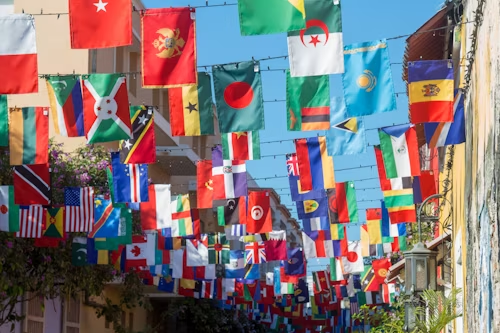Unveiling the Tapestry of Humanity: 40+ Captivating Cultural Facts:
Human history is an intricate and vibrant tapestry woven with countless threads of culture. From the grandest empires to the smallest communities, each civilization has contributed unique customs, beliefs, innovations, and artistic expressions that continue to shape our world today. Embark on a journey of discovery with us as we delve into over 40 mind-blowing cultural facts that highlight the richness and diversity of our shared past. Prepare to have your perspective broadened and your curiosity ignited!
Ancient Innovations and Milestones:

The foundations of our modern world were laid by ingenious minds from ancient cultures. Let’s explore some of their remarkable achievements:
The Cradle of Writing:
- Fact 1: The earliest known form of writing originated in Mesopotamia, specifically Sumer, around 3200 BCE. These cuneiform scripts were initially used for record-keeping and administration.
- Fact 2: Ancient Egyptians developed hieroglyphs around the same time, a complex system of pictorial symbols used for religious texts and royal inscriptions.
Architectural Marvels:
- Fact 3: The Great Pyramid of Giza, built around 2580-2560 BCE, was the tallest man-made structure for over 3,800 years. Its precision and scale remain awe-inspiring.
- Fact 4: The Romans were pioneers in concrete construction, enabling them to build massive structures like the Colosseum and aqueducts that still stand today.
Early Systems of Governance and Law:
- Fact 5: The Code of Hammurabi, created in ancient Babylon around 1754 BCE, is one of the earliest known written legal codes, outlining rules and punishments for various offenses.
- Fact 6: Ancient Greece gave birth to democracy in Athens around the 5th century BCE, a revolutionary concept where citizens directly participated in governance.
Scientific and Mathematical Breakthroughs:
- Fact 7: The concept of zero as a number was developed in India around the 9th century CE, a fundamental contribution to mathematics.
- Fact 8: Ancient Chinese civilizations made significant advancements in astronomy, accurately charting constellations and predicting eclipses.
Global Traditions and Customs:

The diversity of human culture is beautifully expressed through a myriad of traditions and customs practiced around the world:
Celebrations and Rituals:
- Fact 9: The Day of the Dead (Día de Muertos) in Mexico is a vibrant celebration where families honor and remember their deceased loved ones with colorful altars, food, and festivities.
- Fact 10: The Japanese tea ceremony (Chanoyu) is a highly ritualized and graceful practice emphasizing harmony, respect, purity, and tranquility.
- Fact 11: Diwali, the Hindu festival of lights, symbolizes the victory of light over darkness and good over evil, celebrated with lamps, fireworks, and festive gatherings.
Culinary Heritage:
- Fact 12: The ancient Romans enjoyed elaborate feasts and were known for their sophisticated cuisine, incorporating ingredients from across their vast empire.
- Fact 13: The tradition of pasta making in Italy dates back centuries, with regional variations and techniques passed down through generations.
- Fact 14: The use of spices in Indian cuisine has a long history, with complex blends creating unique and flavorful dishes.
Artistic Expressions:
- Fact 15: Aboriginal rock art in Australia is one of the oldest continuous art traditions in the world, dating back tens of thousands of years and depictingDreamtime stories.
- Fact 16: The intricate patterns and vibrant colors of African textiles often carry symbolic meanings and reflect cultural identity.
- Fact 17: Traditional Chinese calligraphy is considered a high art form, emphasizing brushstrokes, balance, and the expressive power of characters.
Social Structures and Beliefs:
- Fact 18: The concept of “ubuntu” in many African cultures emphasizes community, humanity, and interconnectedness.
- Fact 19: The caste system in India, though historically rigid, has profoundly influenced social structures and continues to be a complex aspect of Indian society.
- Fact 20: The samurai in feudal Japan followed a strict code of conduct known as Bushido, emphasizing honor, loyalty, and martial prowess.
Fascinating Cultural Evolutions:

Cultures are not static; they constantly evolve and adapt over time, influenced by various factors:
The Spread of Religions:
- Fact 21: Buddhism, originating in India, spread across Asia, adapting and diversifying into various schools of thought and practice.
- Fact 22: The spread of Islam from the Arabian Peninsula led to the flourishing of Islamic art, science, and philosophy across vast territories.
- Fact 23: Christianity, originating in the Middle East, became a dominant religion in Europe and subsequently spread globally through exploration and missionary efforts.
The Impact of Trade and Exchange:
- Fact 24: The Silk Road, an ancient network of trade routes, facilitated the exchange of goods, ideas, and cultural practices between the East and West.
- Fact 25: The Columbian Exchange, following European exploration of the Americas, led to the widespread transfer of plants, animals, culture, human populations, technology, diseases, and ideas between the Old World and the New World.
The Influence of Innovation and Technology:
- Fact 26: The invention of the printing press by Johannes Gutenberg in the 15th century revolutionized the spread of knowledge and ideas, profoundly impacting culture and society.
- Fact 27: The Industrial Revolution in the 18th and 19th centuries led to significant social and cultural changes, transforming agrarian societies into industrial ones.
Unexpected Cultural Facts:
Sometimes, the most intriguing cultural facts are those that surprise us:
- Fact 28: In some cultures, like parts of Southeast Asia, betel nut chewing is a long-standing social custom with cultural and sometimes ritualistic significance.
- Fact 29: The tradition of wearing kilts in Scotland has a long and storied history, with different tartans associated with specific clans.
- Fact 30: The act of bowing as a sign of respect varies significantly in depth and duration across different East Asian cultures.
Modern Cultural Shifts:
Culture continues to evolve rapidly in the modern era, influenced by globalization and technology:
- Fact 31: The rise of social media has created new forms of cultural expression and interaction, connecting people across geographical boundaries.
- Fact 32: The increasing awareness of environmental issues has led to the emergence of “green” cultural practices and a greater emphasis on sustainability.
- Fact 33: The blending of cultures through migration and global communication has resulted in vibrant and diverse multicultural societies.
Preserving Our Cultural Heritage:
Understanding and appreciating cultural facts is crucial for preserving our shared human heritage:
- Fact 34: UNESCO World Heritage Sites recognize and protect culturally significant places around the world, ensuring their preservation for future generations.
- Fact 35: Museums and cultural institutions play a vital role in showcasing and educating the public about different cultures and their histories.
- Fact 36: Efforts to revive and preserve endangered languages are crucial for maintaining cultural diversity and the unique knowledge they hold.
Test Your Cultural Knowledge: Q&A:
Q: Which ancient civilization is credited with the invention of the wheel? A: While the exact origin is debated, evidence suggests that the wheel was first developed in Mesopotamia around the 4th millennium BCE.
Q: What is the significance of the cherry blossom (sakura) in Japanese culture? A: Cherry blossoms symbolize the beauty and transience of life and are celebrated during the Hanami festival.
Q: What is a common greeting in Maori culture? A: A common greeting is “Kia ora,” which can mean hello, goodbye, thank you, and well wishes.
Conclusion: A World of Cultural Wonders:
Exploring cultural facts offers a fascinating glimpse into the ingenuity, creativity, and diversity of humanity throughout history. From ancient inventions to vibrant traditions and ongoing cultural shifts, the tapestry of human culture is rich and ever-evolving. By learning about these mind-blowing facts, we gain a deeper appreciation for the unique contributions of different societies and the interconnectedness of our shared human experience. Keep exploring, keep learning, and continue to be amazed by the wonders of our world’s rich history!
Share your favorite cultural fact in the comments below! What other aspects of global culture intrigue you? Let’s continue the conversation!
